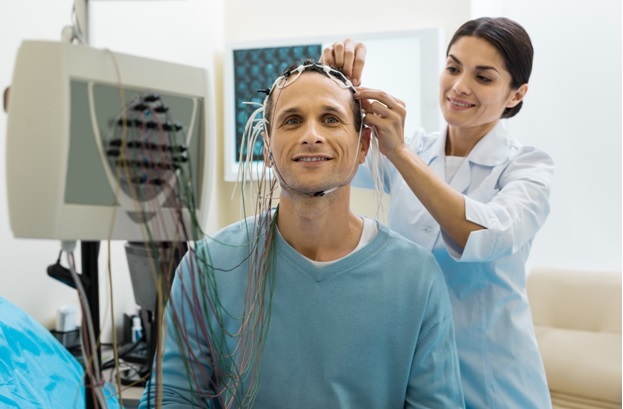Nearly a century after electroencephalography (EEG) recordings were first taken, they have become among the most significant neurological testing procedures and have become indispensable for diagnosing a variety of ailments, ranging from sleep disorders to epilepsy.
While the first EEG was recorded through two electrodes placed on the scalp, the procedure has evolved greatly, in terms of the type and quality of electrodes used, as well as in methodology.
This short article will investigate some of the methods by which the quality of an EEG recording may be improved, through the use of superior materials and protocols.
Materials: Electrodes, Paste, Gel, Etc.
Unlike in other electrical bio-signal recordings, such as electromyography and electrocardiography, electroencephalography is somewhat more complicated due to the skull’s composition, which reduces the amplitude of EEG waves. As a result, one aspect of recording quality EEG signals comes from the use of high-quality EEG electrodes.2
While some EEG electrodes are needles, many are cups or disc electrodes made with gold or silver chloride.
Silver chloride cup electrodes are often a top choice because silver chloride is a soluble salt that quickly dissolves and comes to equilibrium. Its high conductivity and low impedance make it an excellent choice as a material for skin-surface electrodes to be used in EEG recordings.
However, there is a wide range of other materials used to produce EEG electrodes, including tin, stainless steel, and even platinum and gold. The latter two tend to be more expensive, but despite the relative advantages of silver chloride electrodes have their own virtues.
The advantages of gold EEG electrodes, for instance, are due to the chemical nobility of gold. While silver chloride comes to equilibrium quickly and delivers high-quality biosignal recordings, due to the compound’s reactivity they can lose their efficacy over time. By contrast, gold cup EEG electrodes maintain their efficacy and in some instances are even superior, particularly for patients at risk of metal-related skin reactions.
Cup-shaped electrodes are often used with an electrolyte, a conductive paste or gel that itself contains chloride ions. In this instance, factors such as skin preparation and electrode temperature will influence impedance; not just the materials used.
Methodology

Typically, 21 EEG electrodes are placed on the scalp before a recording (although between 1 and 256 may be used). Proper skin preparation is crucial to ensure a viable level of impedance (between 1 and 10kΩ), and a conductive gel or paste is typically also used.2
In addition to improper application or skin preparation, the patient’s perspiration and inadvertent movements (including involuntary movements like blinking and the patient’s heartbeat) can create artifacts that compromise the fidelity of the recording.
Another concern when administering EEG testing is electromagnetic interference (EMI), which arises from many sources, including but not limited to service radios, cell phones, RFID devices, and even lights. Something as simple as a fluorescent lamp 2 meters away from an EEG patient can create an electric field pronounced enough to interfere with biosignal recordings.2
Professionals administering the test should instruct the patient to remain as still as possible as all movements can cause artifacts. Effective grounding techniques should also be practiced.
Suitable electrodes should be used for the test, and proper electrode contact impedance values should be established (higher than 1kΩ but lower than 10kΩ, as stated) in order to acquire a proper signal.
Not only to acquire a suitable signal, but also for the purposes of digitizing and storing data, a suitable filter band must also be selected.
Quality Gold Cup EEG Electrodes & More
At LifeSync, we have more than 50 years of experience producing high quality medical electrical equipment.
This includes a wide range of accessories for EEG recordings, including but not limited to gold cup EEG electrodes, silver cup electrodes, lead wires, lead extenders, conductive paste, and more.
Excellent signal quality starts with high quality electrodes and leads that produce minimal impedance and consistent results. Whether you need single-use disposable electrodes or reusable electrodes, get them through our catalog.
If you have any questions about our EEG products or specifications, get in touch with us directly at 1-800-358-2468.
Sources
- Di Flumeri G, Aricò P, Borghini G, Sciaraffa N, Di Florio A, Babiloni F. The Dry Revolution: Evaluation of Three Different EEG Dry Electrode Types in Terms of Signal Spectral Features, Mental States Classification and Usability. Sensors (Basel). 2019 Mar 19;19(6):1365. doi: 10.3390/s19061365. PMID: 30893791; PMCID: PMC6470960.
- Usakli AB. Improvement of EEG signal acquisition: an electrical aspect for state of the art of front end. Comput Intell Neurosci. 2010;2010:630649. doi: 10.1155/2010/630649. Epub 2010 Feb 2. PMID: 20148074; PMCID: PMC2817545.

